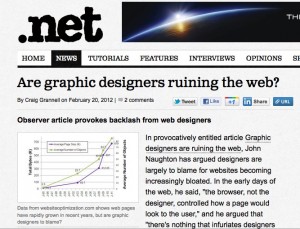
My Observer column last Sunday (headlined “Graphics Designers are Ruining the Web”) caused a modest but predictable stir in the design community. The .Net site published an admirably balanced round-up of comments from designers pointing out where, in their opinions, I had got things wrong. One (Daniel Howells) said that I clearly “had no exposure to the many wonderful sites that leverage super-nimble, lean code that employ almost zero images” and that I was “missing the link between minimalism and beautiful designed interfaces.” Designer and writer Daniel Gray thought that my argument was undermined “by taking a shotgun approach to the web and then highlighting a single favoured alternative, as if the ‘underdesigned’ approach of Peter Norvig is relevant to any of the other sites he discusses”.
There were several more comments in that vein, all reasonable and reasoned — a nice demonstration of online discussion at its best. Reflecting on them brought up several thoughts:
The Columnist’s Dilemma: writing a column about technology for a mainstream newspaper means that one is always trying to balance the temptation to go into technical detail against the risk of losing the non-technical reader. Sometimes I get the balance wrong. In this particular case I thought that getting into the pros and cons of, say, using Javascript to enhance usability, would obscure the main point I was trying to make, which is that there is an epidemic of obesity in web pages, and that that has some downsides.
There’s the question of what are columnists for? I remember something that Alan Rusbridger, the Editor of the Guardian, said when asked why he employed columnists like Simon Jenkins who annoyed the (mainly left-of-centre) readers of the paper. The essence of Rusbridger’s response, as I remember it, was that he needed to avoid creation of an echo-chamber — a publication in which readers only received views with which they agreed. Grit in the oyster, if you like. So perhaps one of the responsibilities of a columnist is to be provocative.
One thing I wish I had mentioned is that it isn’t just designers who are responsible for data-intensive web pages: it’s the slot-in advertising that is often the culprit. And here the responsibility for obesity lies with e-commerce. And here the column links to an earlier one, picking up Evgeny Morozov’s point about the way in which the Web has moved from being a cabinet of curiosities to an endless shopping mall.
The most common response to the column, though, was a casual shrug. So what if web pages are getting bigger and bigger? Network bandwidth will increase to meet the demand — and this may be a good thing: look at the way the demands of desktop publishing and, later, image and video editing pushed the development of personal computing technology. And of course there’s something in that argument: without the constant pressure to push the envelope, technology stagnates. The problem with that argument, however, is that for many Internet users bandwidth is not infinite. I don’t know what proportion of UK users in rural areas, for example, have a landline broadband connection that generally exceeds 2Mbps, but it sure as hell isn’t 100. And as more and more people access the Net via mobile connections, then bandwidth constraints really matter, and will continue to do so for the foreseeable future.
Thanks to Seb Schmoller for the .Net link.

